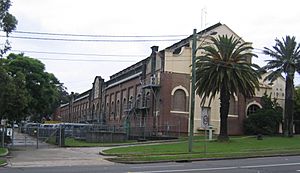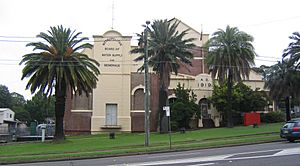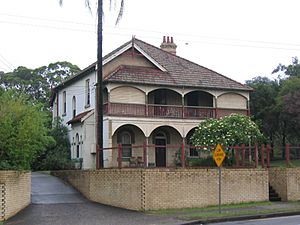Ryde Pumping Station facts for kids
Quick facts for kids Ryde Pumping Station |
|
|---|---|

West Ryde pumping station
|
|
| Location | Victoria Road, West Ryde, City of Ryde, New South Wales, Australia |
| Built | 1891–1921 |
| Built for | Metropolitan Board of Water Supply and Sewerage |
| Owner | Sydney Water |
| Official name: Ryde Pumping Station and site; WP005; West Ryde Pumping Station | |
| Type | State heritage (built) |
| Designated | 15 November 2002 |
| Reference no. | 1634 |
| Type | Water Pump House/Pumping Station |
| Category | Utilities - Water |
| Builders |
|
| Lua error in Module:Location_map at line 420: attempt to index field 'wikibase' (a nil value). | |
The Ryde Pumping Station is a special historic site in West Ryde, Australia. It has old buildings and equipment that were used to pump water. It is located on Victoria Road in the City of Ryde. This station was built between 1891 and 1921. Companies like William Adams & Co. Ltd. helped build it. It is also known as West Ryde Pumping Station. Today, Sydney Water owns the property. It was added to the New South Wales State Heritage Register on 15 November 2002. This means it is an important part of history that needs to be protected.
Contents
History of the Ryde Pumping Station
The area around Ryde was once great for farming. Early settlers received land here to grow crops. In 1792, land was given to soldiers and convicts. Over time, large landowners bought these farms. The district stayed an important area for orchards (fruit farms) throughout the 1800s.
First Pumping Station
The very first pumping station in Ryde was built in 1891. It was then given to a new group called the Metropolitan Board of Water Supply and Sewerage. This station helped move water from the Potts Hill Reservoir. The water went to a storage tank near West Ryde railway station. From there, powerful engines lifted the water. They sent it to Ryde and Chatswood tanks. This supplied water to homes in Sydney's northern areas.
Building the New Station
By 1916, Sydney needed even more water. The old station was not big enough. So, a much larger pumping station was built next to it. The new station was finished in 1921. It started working on September 15 of that year. Slowly, the new station took over all the pumping jobs. The old station stopped working in November 1930. It was used for storage for a while, then taken down in 1961.
The new pumping station kept getting bigger and better. Its ability to pump water grew a lot over the years. In 1921, it could pump 20 million litres of water per day. By 1982, it could pump 590 million litres daily!
In 1921, the station pumped water to many places. These included Chatswood, Pymble, Wahroonga, and Beecroft. This meant it supplied most of Sydney's North Shore.
Powering the Pumps
At first, the pumps used steam power. But by 1982, the station switched to electricity. This made the pumps much more powerful. With 13 electric pumps, the station could move 700 million litres of water each day. This change made Ryde the largest water pumping station in Australia at that time. It was a huge step forward in water supply technology.
Nature Around the Station
The Ryde area used to have thick forests. These included trees like Turpentine and Grey Gum. Over the years, much of the forest was cleared. This happened for timber, farming, and later for new houses. Today, some small parts of the original bushland still exist. The grounds around the pumping station have also been changed. They now have more office buildings.
What the Ryde Pumping Station Looks Like
The Ryde Pumping Station is in West Ryde. It is next to Victoria Road and a railway line. The site is still used for pumping water. It also has offices for Sydney Water staff. These offices are in a mix of old and new buildings.
Main Pumping Station Building
The main pumping station building faces Victoria Road. It has a small office area, the Engine House, and the Boiler House. There is also a concrete bridge, called a coal staith. This bridge allowed trains to bring coal right to the top of the building. The coal was then dropped into bunkers inside. Below the Engine and Boiler Houses are basements. These held important equipment like pumps.
The Boiler House is in the middle of the station. It is taller than the other parts. Its roof still has the original tiles. Inside, it used to have rail lines and coal bunkers. The old boilers have been removed.
Next to the Boiler House is the Economiser House. It is lower and used to hold equipment that made the boilers work better. It is now empty.
Other Historic Structures
- Original Reservoir Valve House: This is a small brick building. It is located near the old water storage tank. It is now disused and boarded up.
- Original Suction Tank (Reservoir): This was a large concrete tank. It was partly buried in the ground. A new roof was added later. It is no longer used for water storage but helps control water pressure.
- Old Railway Tracks: You can still see signs of old railway tracks. These tracks brought coal to the original pumping station.
- Skid Shed: There is an old timber and corrugated iron shed. It was used to store equipment. It is a rare example of how things were done in the past.
- Engineer's Residence: This is a historic brick house. It was where the engineer in charge lived. It is well-preserved and shows how homes looked in the late 1800s.
- Efficiency Engineer's Office: This brick building was built in 1921. It was used as an office and is still in good condition.
Inside the Pumping Station
The main pumping station building is made of brick. It has steel-framed windows. Some windows have been changed over time. Inside the offices, many original features are still there. The Engine House now holds modern pumps. These were installed after the station switched to electricity in the late 1970s and early 1980s. Many of the pipes and valves are also from this later period.
The roof of the Engine House is made of metal. It has original timber vents. At the southern end, there is an extension called the Mobbs Hill extension. Next to it is a workshop building. There is also an old paint shop and a concrete tank for ash.
Near the Hermitage Road entrance, there is a small brick pump and valve house. This building dates from the early to mid-1900s.
Plants and Trees
The site has many old trees and plants. Some, like Canary Island palms, were planted when the station was built in the 1920s. These plants were chosen to make the site look beautiful. There are also some very old native trees. These include Grey Gums and Turpentines. They are remnants of the forests that used to cover the area. Some old Pepper Trees from the farming days are also still there.
Even though much of the original machinery has been replaced, the buildings and landscape still show its history. The site tells a story of how water was supplied to Sydney over many years.
Why Ryde Pumping Station is Important
The Ryde Pumping Station is very important for several reasons. It is a key part of Sydney's water supply history. When it was finished, it was the biggest water pumping station in Australia. Even today, it still performs its original job of supplying water.
Historical Importance
- It shows how water was supplied to northern Sydney for many years.
- It was once the most important pumping station in the Sydney Water system.
- The site has clear evidence of old work methods. These are now rare to see.
- The plants on the site show four different periods of its history. These include native plants, farm trees, and plants from the 1920s station development.
Design and Beauty
- The buildings and landscape of the Ryde Pumping Station are very noticeable in Ryde.
- They show the high quality of industrial design from that time.
- The main buildings and the way the site is laid out show how important this place was.
- The group of buildings and plants facing Victoria Road is a well-known local landmark.
Community Value
- Many people and groups value the pumping station.
- Organisations like the National Trust see its importance.
- It has played a big role in Sydney's development.
- The station is a familiar and important landmark for the local community.
Scientific and Technical Value
The Ryde Pumping Station was a place of new ideas in water supply technology.
- In 1906, it used early turbine-powered pumps.
- In 1918, it used reinforced concrete for chimneys. This was quite new then.
- It used electrically welded steam pipes in 1921.
- It had a system for collecting ash using air in 1923.
- It also used a "cement gun" for rendering and burned powdered coal for fuel.
The site has many rare features. These include the coal bridge and old railway lines. It also has the engineer's residence and other old buildings. These give clues about how people worked there in the past. The native plants on the site also help us understand what the area was like before European settlement.
Rarity and Representation
The West Ryde Pumping Station is a very important example of water pumping technology. It is one of the most complete examples in New South Wales, and possibly Australia. The plants from the 1920s are also rare examples of government landscape design.
The station shows how water supply systems worked across Sydney. While no other station was as big, Ryde Pumping Station represents this important class of places.
Engineering Heritage Award
The Ryde Pumping Station received a special award. It was given an Engineering Heritage National Marker by Engineers Australia. This award recognises its importance in engineering history.



